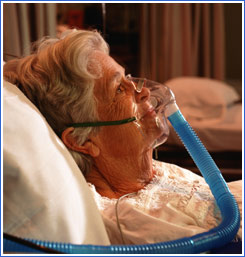Aspiration Pneumonia
Aspiration of oral bacteria is associated with pneumonia, particularly in bedridden and hospitalized patients. Consider the following:
- 83% of patients who develop nosocomial pneumonias are mechanically ventilated.
- Oral care protocol interventions led to an 89.7% reduction in ventilator associated pneumonia.
- Oral hygiene strategies in hospitalized and nursing home populations also can reduce the incidence of pneumonia.

References
Azarpazhooh A, Leake JL. Systematic review of the association between respiratory diseases and oral health. J Periodontology 2006; 77:1465-1482.
Hutchins K, et al. Ventilator-associated pneumonia and oral care: A successful quality improvement project. Am J Infect Control 2009; (37):590-597.
Scannapieco FA. Pneumonia in nonambulatory patients, Journal of the American Dental Association 2006; 137(10 supplement):21S-25S.
Shay K, Scannapieco FA, Terpenning MS, et al. Nosocomial pneumonia and oral health. Spec Care Dentistry 2005; 25(4):179-187.
Scannapieco FA and Shay K, Oral health disparities in older adults: Oral bacteria, inflammation, and aspiration pneumonia. Dental Clinics of North America. 2014; 58(4): 771-782
Sørensen RT et al. Dysphagia screening and intensified oral hygiene reduce pneumonia after stroke. J Neurosci. 2013; 45(3): 139-146.
van der Maarel-Wierink CD et al. Oral health care and aspiration pneumonia in frail older people: a systematic literature review. Gerodontology. 2013; 30(1): 3-9.